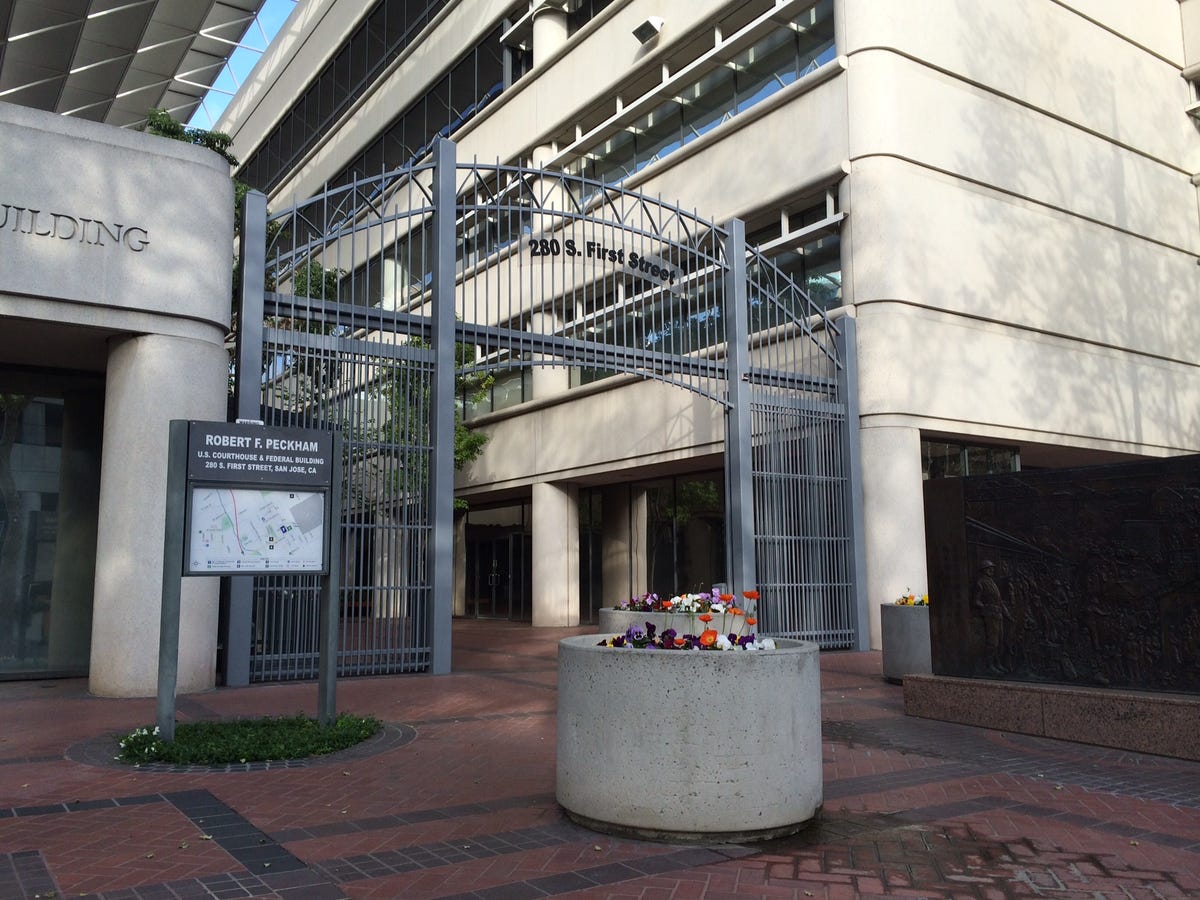
Apple
SAN JOSE, Calif. — Venice isn’t just a picturesque city in Italy. It’s also the code name used for Apple’s FaceTime technology.
Roberto Garcia, an Apple engineer currently in charge of iMessage, on Tuesday revealed details about the company’s development of the FaceTime video calling program. Along with the code name, Garcia detailed the work he and other engineers did to create FaceTime and what they hoped to accomplish with the technology.
“I’m extremely proud of the work I did on FaceTime,” Garcia said.
He added that “one of the proudest moments” in his life was a launching a FaceTime call with his mother-in-law shortly after his daughter was born in 2011. She couldn’t be at the birth, Garcia said, but the call made her feel more connected.
“We heard her bawling in crystal clear audio in the moments afterward,” Garcia said. “She told me she felt like she was right there. That’s what we aimed for when we created FaceTime.”
The testimony came during the fourth week of a patent-infringement trial between Apple and Samsung. Apple has accused Samsung of infringing five patents, while Samsung has accused Apple of copying two of its patents. One of those wielded by Samsung — No. 239 — relates to the transfer of video, and the Korean giant says FaceTime infringes the technology. Apple called Garcia to the stand to show that Samsung’s patent wasn’t important to the development of FaceTime.
Related links
- Apple v. Samsung: All you need to know about latest patent trial (FAQ)
- Tech novices set to determine the fate of Apple v. Samsung
- Apple: Samsung patent case is not about Google
- Apple: Samsung purposely copied iPhone after suffering ‘crisis of design’
- Apple expert: iPhone-like features boosted Samsung phone sales
Almost two years after Apple and Samsung faced off in a messy patent dispute, the smartphone and tablet rivals have returned to the same San Jose, Calif., courtroom to argue once again over patents before Federal Judge Lucy Koh. Apple is arguing that Samsung infringed on five of its patents for the iPhone, its biggest moneymaker, and that Apple is due $2 billion for that infringement. Samsung wants slightly more than $6 million from Apple for infringing two of its software patents.
While the companies are asking for damages, the case is about more than money. What’s really at stake is the market for mobile devices. Apple now gets two-thirds of its sales from the iPhone and iPad; South Korea-based Samsung is the world’s largest maker of smartphones; and both want to keep dominating the market. So far, Apple is ahead when it comes to litigation in the US. Samsung has been ordered to pay the company about $930 million in damages.
Most Samsung features that Apple says infringe are items that are a part of Android, Google’s mobile operating system that powers Samsung’s devices. All patents except one, called “slide to unlock,” are built into Android. Apple has argued the patent infringement trial has nothing to do with Android. However, Samsung argues that Apple’s suit is an ” attack on Android” and that Google had invented certain features before Apple patented them.
In the case, Apple and Samsung have accused each other of copying features used in their popular smartphones and tablets, and the jury will have to decide who actually infringed and how much money is due. This trial involves different patents and newer devices than the ones disputed at trial in August 2012 and in a damages retrial in November 2013. For instance, the new trial involves the iPhone 5 , released in September 2012, and Samsung’s Galaxy S3 , which also debuted in 2012.
Garcia testified Tuesday that he started working on a prototype in 2007 that allowed him to connect his phone to his Mac to make voice calls. The next year, he and other engineers were able to decode a video frame from a Mac on a phone. However, that was as far as the engineers could take the prototype, Garcia said.
He then started working on a project called Game Kit to allow developers to write apps that could pay games with each other and also do voice chat.
“In 2008 it became clear…the iPhone was a great gaming platform,” Garcia said.
Apple in 2009 expanded Game Kit into Game Center, a gaming social network that allows Apple device users to see friends’ high scores and other information. As part of his work on Game Center, Garcia expanded voice chat to include multiple people. He then started on what’s now known as FaceTime, using much of the same code as in Game Center.
“Code writing for Game Center turned out to be really useful for FaceTime,” Garcia said.
The FaceTime project, codenamed Venice, included many pieces, such as networking for seamless interaction. Garcia and four other engineers spent essentially all of their time on the project, and various other teams worked on pieces related to the technology. Apple’s core audio team did the audio backend, dealing with the microphone and speaker, Garcia said. The video codec team also was involved, as was the application team, “which draws pretty buttons and things like that,” he said.


Shara Tibken/CNET
The engineers wrote “at least tens of thousands of lines of code.” Garcia noted that then-CEO Steve Jobs hated the FaceTime experience when the engineers first started demoing it. What he wanted was people to be able to use the technology right out of the box, so they worked to build the backend for the video calling, as well as creating stronger security.
They also made sure FaceTime didn’t record or save any videos to protect user privacy and address security concerns.
“I don’t want my video calls recorded by anybody or seen by anyone, so I and everyone on my team took security and privacy very seriously,” Garcia said.
Apple introduced a Wi-Fi version of FaceTime in June 2010 and released a cellular version in 2012. Garcia said he received five patents for his work related to FaceTime.
Earlier Tuesday, Samsung revealed that it has reduced the amount of damages it wants for Apple’s accused infringement of two patents because it dropped the iPad from the list of infringing devices. Apple should pay Samsung about $6.2 million, testified Brigham Young University economics professor James Kearl, an expert hired by the Korean electronics maker to calculate damages. Earlier in the trial, Samsung asked for about $6.8 million in damages.
The difference comes from the ‘239 patent that covers video transfer. Samsung now wants $6.07 million in damages for infringement of the patent. Earlier, it asked for $6.78 million. The company dropped infringement claims against the iPad 2, iPad 3, iPad 4, and iPad Mini over the weekend, Kearl said. For its ‘449 patent related to camera and folder organization, Samsung still wants $158,400 in damages.
The latest trial kicked off March 31 with jury selection. The following day featured opening arguments and testimony by Phil Schiller, Apple’s head of marketing. Other witnesses who have testified include Greg Christie, an Apple engineer who invented the slide-to-unlock iPhone feature; Thomas Deniau, a France-based Apple engineer who helped develop the company’s quick link technology; and Justin Denison, chief strategy officer of Samsung Telecommunications America. Denison’s testimony came via a deposition video.
Apple v. Samsung 2014: The gadgets in question






Apple experts who took the stand over the past few weeks included Andrew Cockburn, a professor of computer science and software engineering at the University of Canterbury, New Zealand; Todd Mowry, a professor of computer science at Carnegie Mellon University; and Alex Snoeren, a professor of computer science and engineering at the University of California at San Diego.
The crux of Apple’s case came with two expert witnesses, John Hauser, the Kirin professor of marketing at the MIT Sloan School of Management; and Christopher Vellturo, an economist and principal at consultancy Quantitative Economic Solutions. Hauser conducted a conjoint study that determined Apple’s patented features made Samsung’s devices more appealing, while Vellturo determined the amount of damages Apple should be due for Samsung’s infringement — $2.191 billion.
Samsung, which launched its defense April 11 after Apple rested its case, called several Google engineers to the stand to testify about the early days of Android and technology they created before Apple received its patents. Hiroshi Lockheimer, Google vice president of engineering for Android, said his company never copied iPhone features for Android. Other Google Android engineers, Bjorn Bringert and Dianne Hackborn, also testified about features of the operating system.
High-ranking Samsung executives, including former Samsung Telecommunications America CEO Dale Sohn and STA Chief Marketing Officer Todd Pendleton, also took the stand during the weeks-long trial. The two executives testified about Samsung’s marketing push for the Galaxy S2 and other devices, saying a shift in the Korean company’s sales and marketing efforts — not copying Apple — boosted its position in the smartphone market.
The past several days of testimony have largely been experts hired by Samsung to dispute the validity of Apple’s patents and to argue that Samsung didn’t infringe. The experts include Martin Rinard, an MIT professor of computer science; Saul Greenberg, a professor of human computer interaction at the University of Calgary in Canada; Kevin Jeffay, professor of computer science at the University of North Carolina, Chapel Hill; and Daniel Wigdor, a computer science professor at the University of Toronto.
See also
- Samsung: Apple’s case ‘is an attack on Android’
- Samsung: Apple ‘vastly overstated’ scope of patents
- Apple’s Phil Schiller: Samsung’s copying makes people ‘question’ our innovation
- Apple: Samsung made ‘false statements’ during opening argument
- Apple rests case vs. Samsung after expert makes pitch on damages
David Reibstein, chaired professor of marketing at the University of Pennsylvania’s Wharton School of Business, on Friday refuted Apple expert Hauser’s testimony from earlier this month. NYU Stern School of Business professor Tulin Erdem, meanwhile, on Friday also testified that she conducted her own studies, using eye tracking, to determine what devices consumers would buy. She concluded that Apple’s patented features didn’t boost desire for Samsung’s products.
Monday, Judith Chevalier, a professor of economics and finance at the Yale University School of Management who was hired by Samsung, said her analysis determined that a reasonable royalty for Samsung’s assumed infringement would be $1.75 per device, or $38.4 million overall. Apple had argued it deserved $40 per device for infringement as well as lost profits for a total of $2.191 billion.
There are seven patents at issue in the latest case — five held by Apple and two by Samsung. Apple has accused Samsung of infringing US patents Nos. 5,946,647; 6,847,959; 7,761,414; 8,046,721; and 8,074,172. All relate to software features, such as “quick links” for ‘647, universal search for ‘959, background syncing for ‘414, slide-to-unlock for ‘721, and automatic word correction for ‘172. Overall, Apple argues that the patents enable ease of use and make a user interface more engaging.
Samsung, meanwhile, has accused Apple of infringing US patents Nos. 6,226,449 and 5,579,239. The ‘449 patent, which Samsung purchased from Hitachi, involves camera and folder organization functionality. The ‘239 patent, which Samsung also acquired, covers video transmission functionality and could have implications for Apple’s use of FaceTime.
The Samsung gadgets that Apple says infringe are the Admire, Galaxy Nexus , Galaxy Note , Galaxy Note 2, Galaxy S2, Galaxy S2 Epic 4G Touch, Galaxy S2 Skyrocket, Galaxy S3, Galaxy Tab 2 10.1, and the Stratosphere. Samsung, meanwhile, says the iPhone 4 , iPhone 4S, iPhone 5, iPod Touch (fifth generation) and iPod Touch (fourth generation) all infringe.
The arguments by Apple and Samsung in the latest case should finish by the end of April. Court will be in session three days each week — Mondays, Tuesdays, and Fridays — though the jury will deliberate every business day until it has reached a verdict. Closing arguments likely will take place April 28.
Up close and personal with the Samsung Galaxy S3 (pictures)









